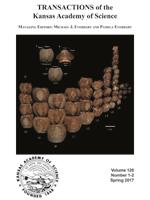Passive integrated transponder (PIT) tags are commonly used to uniquely identify tagged individuals. Much of what we currently know about the feasibility of using PIT tags in fish ecology research has been studied in salmonids. The recent development of smaller tags has prompted research into their effects on small-bodied fishes. In a laboratory setting, I assessed the effects of PIT tags on Red Shiner Cyprinella lutrensis and Sand Shiner Notropis stramineus over 48 days. Survival was high (>97%) for both species. Tag retention was relatively high (82%) for Red Shiner, but low (51%) for Sand Shiner. Logistic regression models testing the effects of length of tagged fishes on survival and tag retention were non-significant. Growth was not affected by the presence of a PIT tag. This study suggests that Red Shiner and Sand Shiner > 45 mm can be successfully tagged with 9 mm PIT tags.
How to translate text using browser tools
1 April 2017
Effects of PIT Tags on Red Shiner Cyprinella lutrensis and Sand Shiner Notropis stramineus
Casey A. Pennock
ACCESS THE FULL ARTICLE
cyprinids
growth
PIT tags
retention
small-bodied fishes
survival





